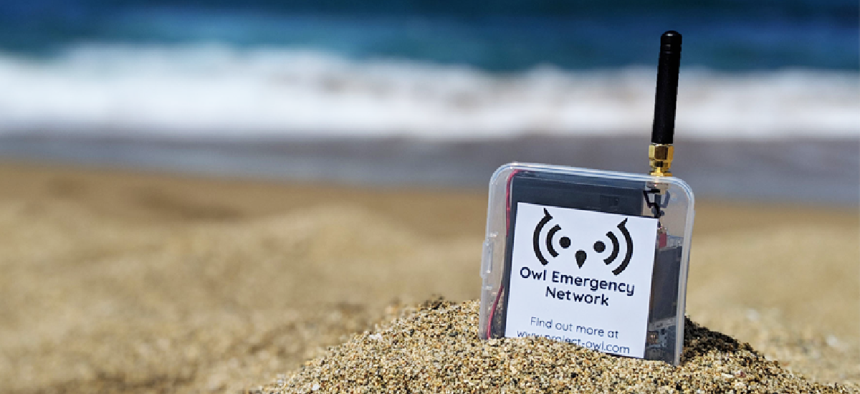Project Owl and its DuckLink network take on disaster response


Connecting state and local government leaders
A startup with a thing for ornithology is working to improve communication between first responders and the public during and after natural disasters.
A startup with a thing for ornithology is working to improve communication between first responders and the public during and after natural disasters.
Project Owl -- so named because of its focus on organization, whereabouts and logistics -- built a solution that is part disaster management system and part cloud software to ensure connectivity during and after an event.
The management system helps responders monitor officials’ locations and what they’re doing through a mapping tool that helps them understand what resources are where. They can access the platform via a smartphone or computer, and they can communicate with it via a conversational interface.
“It’s really easy to get a clear sense of what we call a common operating picture of an incident,” said, Project Owl CEO and co-founder Bryan Knouse. Of course, the catch is that connectivity often gets cut during hurricanes and other disasters.
So Knouse and his handful of teammates also built what they call Ducks, or DuckLinks, small but hearty devices that can be dropped in a cluster -- called a clusterduck -- to create a mesh network to which people in affected areas can connect.
“We found an effective way to deploy essentially what is a very basic internet to a place that has no comms,” Knouse said.
The name grew out of the team’s initial focus on hurricane response; the idea for Ducks came on the heels of hurricanes Maria and Harvey, and they were being built as Hurricane Florence swept the Carolinas last September.
“We love the idea of calling them the clusterduck network, not just because we thought it was comically relevant to the situations we would support, but also it speaks to the technical architecture -- that we’ve really created a clustered mesh network of these Ducks, a clusterduck,” Knouse said, adding that they might have rename it as the company becomes more mainstream.
Each Duck is small -- about the size of a baseball -- and has one button that turns the unit on or off. Within about a second of turning them on, they are transmitting using two wireless communications capabilities: Wi-Fi and LoRa, a spread spectrum modulation technique derived from chirp spread spectrum (CSS) technology that can enable long-range transmissions.
“If you’re near a Duck, you’ll be able to open up your Wi-Fi settings on your phone or on your computer or on any internet-connected device and find our Wi-Fi network and connect to that Duck,” Knouse said. “Wi-Fi gives us an ability to really connect with all the consumer electronic devices that are already out there. We don’t have to give you a special type of phone; you can use whatever type of phone you already have.”
Once connected, a captive portal opens on the user’s device asking for the user's name, location, needs and details about the local situation. Users hit submit and the Duck sends that information over long distances at a low power draw through LoRa to the Owl disaster management system.
By dropping dozens of in an area, "we can cover a large geographical space very quickly at relatively low costs and provide communication to people throughout that region,” Knouse said. What’s more, they are battery-powered and can last anywhere from a day to a week, he added.
DuckLink had its first major test in Puerto Rico in March. The company field tested about 60 Ducks in five regions, with the single largest mesh network at about a square mile. It took 15 minutes to deploy each Duck -- power it on, place it and make sure it was working -- and only about half the messages went through.
The team tried again with another large test deployment in Houston in June, deploying about 50 Ducks in a square mile. This time, it took 90 seconds to power up each device, and the network error rate dropped to 10%.
Next up is a test as part of the Homeland Security Department’s Next Generation First Responder – Birmingham Shaken Fury Operational Experimentation Aug. 22 in Alabama.
Knouse said he expects Project Owl and its Ducks to find uses outside disaster response. The Defense Department has already shown interest in using the small, lightweight devices for Special Forces traveling in areas without traditional communications infrastructure, he said. U.S. Customs and Border Patrol has also inquired about using them in subterranean environments at the southern border, although neither agency has formalized test plans yet.
Additionally, Knouse said he sees potential for adding sensors to Ducks to detect smoke, gas or hazardous materials to increase their value to users.
Last October, Project Owl won IBM’s Call for Code Global Prize, coming in first among 100,000 competitors. As a result, the startup got support from IBM’s Code and Response initiative, which aims to put open-source technologies in the communities that need them most.
“Part of our technology is open source, meaning we said to the greater world wide web, ‘Hey, if this is something that inspires you, if this is a problem you’d like to work on, why don’t you jump into our Slack channel and you can work on this technology with us?’” Knouse said. Last November, five people were in the channel. Today there are almost 170. “The most inspiring piece of this to me is the response we’ve seen from all the individuals across the world who are passionate about building new technology that can make a positive impact.”




